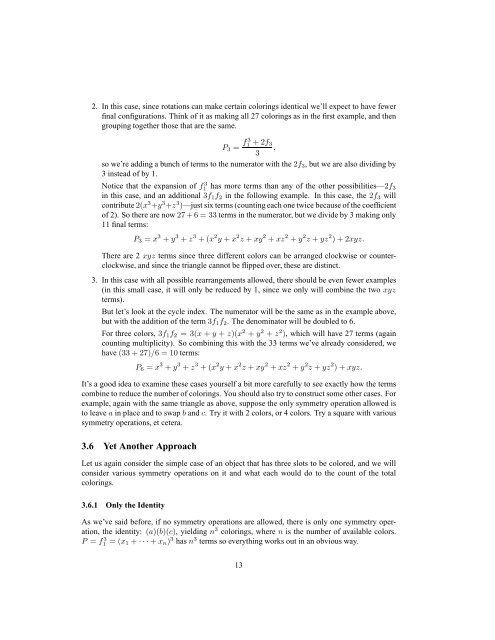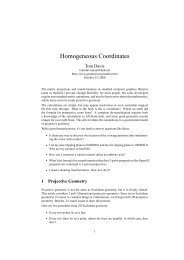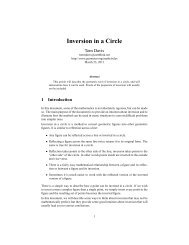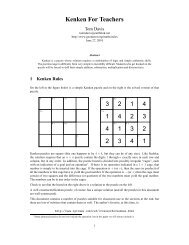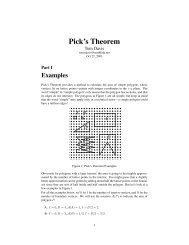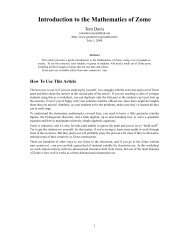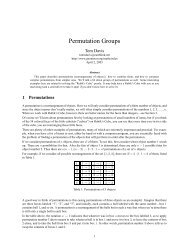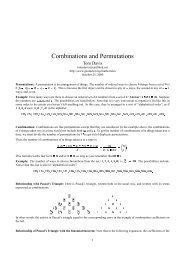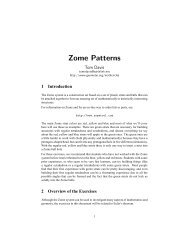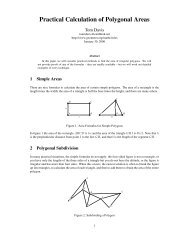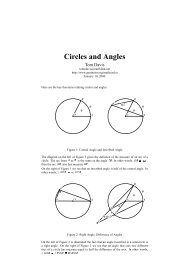P´olya's Counting Theory - Home Page -- Tom Davis
P´olya's Counting Theory - Home Page -- Tom Davis
P´olya's Counting Theory - Home Page -- Tom Davis
Create successful ePaper yourself
Turn your PDF publications into a flip-book with our unique Google optimized e-Paper software.
2. In this case, since rotations can make certain colorings identical we’ll expect to have fewer<br />
final configurations. Think of it as making all 27 colorings as in the first example, and then<br />
grouping together those that are the same.<br />
P 3 = f3 1 + 2f 3<br />
,<br />
3<br />
so we’re adding a bunch of terms to the numerator with the 2f 3 , but we are also dividing by<br />
3 instead of by 1.<br />
Notice that the expansion of f 3 1 has more terms than any of the other possibilities—2f 3<br />
in this case, and an additional 3f 1 f 2 in the following example. In this case, the 2f 3 will<br />
contribute 2(x 3 +y 3 +z 3 )—just six terms (counting each one twice because of the coefficient<br />
of 2). So there are now 27+6 = 33 terms in the numerator, but we divide by 3 making only<br />
11 final terms:<br />
P 3 = x 3 + y 3 + z 3 + (x 2 y + x 2 z + xy 2 + xz 2 + y 2 z + yz 2 ) + 2xyz.<br />
There are 2 xyz terms since three different colors can be arranged clockwise or counterclockwise,<br />
and since the triangle cannot be flipped over, these are distinct.<br />
3. In this case with all possible rearrangements allowed, there should be even fewer examples<br />
(in this small case, it will only be reduced by 1, since we only will combine the two xyz<br />
terms).<br />
But let’s look at the cycle index. The numerator will be the same as in the example above,<br />
but with the addition of the term 3f 1 f 2 . The denominator will be doubled to 6.<br />
For three colors, 3f 1 f 2 = 3(x + y + z)(x 2 + y 2 + z 2 ), which will have 27 terms (again<br />
counting multiplicity). So combining this with the 33 terms we’ve already considered, we<br />
have (33 + 27)/6 = 10 terms:<br />
P 6 = x 3 + y 3 + z 3 + (x 2 y + x 2 z + xy 2 + xz 2 + y 2 z + yz 2 ) + xyz.<br />
It’s a good idea to examine these cases yourself a bit more carefully to see exactly how the terms<br />
combine to reduce the number of colorings. You should also try to construct some other cases. For<br />
example, again with the same triangle as above, suppose the only symmetry operation allowed is<br />
to leave a in place and to swap b and c. Try it with 2 colors, or 4 colors. Try a square with various<br />
symmetry operations, et cetera.<br />
3.6 Yet Another Approach<br />
Let us again consider the simple case of an object that has three slots to be colored, and we will<br />
consider various symmetry operations on it and what each would do to the count of the total<br />
colorings.<br />
3.6.1 Only the Identity<br />
As we’ve said before, if no symmetry operations are allowed, there is only one symmetry operation,<br />
the identity: (a)(b)(c), yielding n 3 colorings, where n is the number of available colors.<br />
P = f 3 1 = (x 1 + · · · + x n ) 3 has n 3 terms so everything works out in an obvious way.<br />
13


